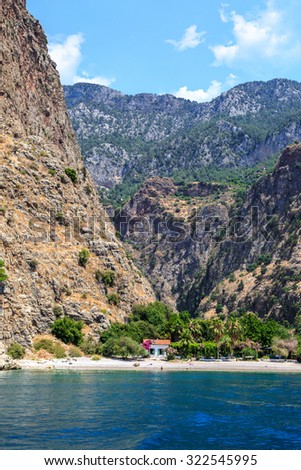 The Monarch Butterfly Biosphere Reserve is a World Heritage Site containing most of the over-wintering sites of the eastern population of the monarch butterfly. The reserve is located in the Trans-Mexican Volcanic Belt pine-oak forests ecoregion on the border of Michoacán and Mexico State, 100 km (62 miles), northwest of Mexico City. Millions of butterflies arrive in the reserve annually. Butterflies only inhabit a fraction of the 56,000 hectares of the reserve from October–March. The biosphere’s mission is to protect the butterfly species and its habitat.
The Monarch Butterfly Biosphere Reserve is a World Heritage Site containing most of the over-wintering sites of the eastern population of the monarch butterfly. The reserve is located in the Trans-Mexican Volcanic Belt pine-oak forests ecoregion on the border of Michoacán and Mexico State, 100 km (62 miles), northwest of Mexico City. Millions of butterflies arrive in the reserve annually. Butterflies only inhabit a fraction of the 56,000 hectares of the reserve from October–March. The biosphere’s mission is to protect the butterfly species and its habitat. Most of the over-wintering monarchs from eastern North America are found here. Western researchers 'discovered' these areas in 1975, though local people had known of the sites before then. Presidential decrees in the 1980s and 2000 designated these still privately held lands area as a federal reserve. The Reserve was declared a Biosphere Reserve in 1980 and a World Heritage Site in 2008. The reserve remains predominantly rural. Reserve administrators continue to be concerned with deleterious effects of illegal logging and tourism. Conservation efforts sometimes conflict with the interests of local farmers, community-based landowners, private land owners and indigenous people.
Most of the over-wintering monarchs from eastern North America are found here. Western researchers 'discovered' these areas in 1975, though local people had known of the sites before then. Presidential decrees in the 1980s and 2000 designated these still privately held lands area as a federal reserve. The Reserve was declared a Biosphere Reserve in 1980 and a World Heritage Site in 2008. The reserve remains predominantly rural. Reserve administrators continue to be concerned with deleterious effects of illegal logging and tourism. Conservation efforts sometimes conflict with the interests of local farmers, community-based landowners, private land owners and indigenous people. Millions of butterflies travel south into Mexico, from Texas and then follow the Sierra Madre Oriental mountains to the preserve. The butterflies congregate, clustering onto pine and oyamel trees. To many, the trees appear orange and branches sag from the weight. Dense congregations are thought to conserve heat. If warmed by the sun, the butterflies take flight. the beating of their wings has been compared to the sound of a light rain. The reserve is susceptible to lethal, freezing temperatures.
Millions of butterflies travel south into Mexico, from Texas and then follow the Sierra Madre Oriental mountains to the preserve. The butterflies congregate, clustering onto pine and oyamel trees. To many, the trees appear orange and branches sag from the weight. Dense congregations are thought to conserve heat. If warmed by the sun, the butterflies take flight. the beating of their wings has been compared to the sound of a light rain. The reserve is susceptible to lethal, freezing temperatures. The reserve was designated in 1980 by President José López Portillo. In the late 1980s reserve management was delegated to the Secretariat of Urban Development and Ecology. It was at this time assigned the category of “special biosphere reserve.” In 1986, the area and boundaries of the zones were defined.[4] In 2000, it received its name (Reserva de la Biosfera Mariposa Monarca). UNESCO declared the biosphere a World Heritage site in 2008 as a Natural Asset.[10] Currently the area is known for tourism, logging, mining and farming. It has remained mostly rural, noted for communities of Otomi and Mazahua.
The reserve was designated in 1980 by President José López Portillo. In the late 1980s reserve management was delegated to the Secretariat of Urban Development and Ecology. It was at this time assigned the category of “special biosphere reserve.” In 1986, the area and boundaries of the zones were defined.[4] In 2000, it received its name (Reserva de la Biosfera Mariposa Monarca). UNESCO declared the biosphere a World Heritage site in 2008 as a Natural Asset.[10] Currently the area is known for tourism, logging, mining and farming. It has remained mostly rural, noted for communities of Otomi and Mazahua. Conservation efforts were first intended to protect the butterfies. Research, conservation and other efforts are now focused on preserving the habitat. The interests of residents, land owners, farmers, farmer cooperatives, and local communities have been taken into account regarding conservation but conflicting interests remain.[11] Even though the Mexican government designated the area as a biosphere reserve most of the area of the preserve is owned by 38 ejidos, seven indigenous communities and 16 private holdings.
Conservation efforts were first intended to protect the butterfies. Research, conservation and other efforts are now focused on preserving the habitat. The interests of residents, land owners, farmers, farmer cooperatives, and local communities have been taken into account regarding conservation but conflicting interests remain.[11] Even though the Mexican government designated the area as a biosphere reserve most of the area of the preserve is owned by 38 ejidos, seven indigenous communities and 16 private holdings.